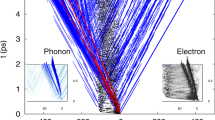Abstract
We investigate polaron formation in a many-electron system in the presence of a local repulsion sufficiently strong to prevent local-bipolaron formation. Specifically, we consider a Hubbard-Holstein model of interacting electrons coupled to dispersionless phonons of frequency ω 0. Numerically solving the model in a small one-dimensional cluster, we find that in the nearly adiabatic case ω 0 < t, the necessary and sufficient condition for the polaronic regime to occur is that the energy gain in the atomic (i.e., extremely localized) regime ε pol overcomes the energy of the purely electronic system ε el. In the antiadiabatic case, ω 0 > t, polaron formation is instead driven by the condition of a large ionic displacement g/ω 0 < 1 (g being the electron-phonon coupling). Dynamical properties of the model in the weak and moderately strong coupling regimes are also analyzed.
Similar content being viewed by others
Author information
Authors and Affiliations
Corresponding author
Rights and permissions
About this article
Cite this article
Capone, M., Grilli, M. & Stephan, W. Small polaron formation in many-particle states of the Hubbard-Holstein model: The one-dimensional case. Eur. Phys. J. B 11, 551–557 (1999). https://doi.org/10.1007/BF03219179
Received:
Published:
Issue Date:
DOI: https://doi.org/10.1007/BF03219179



